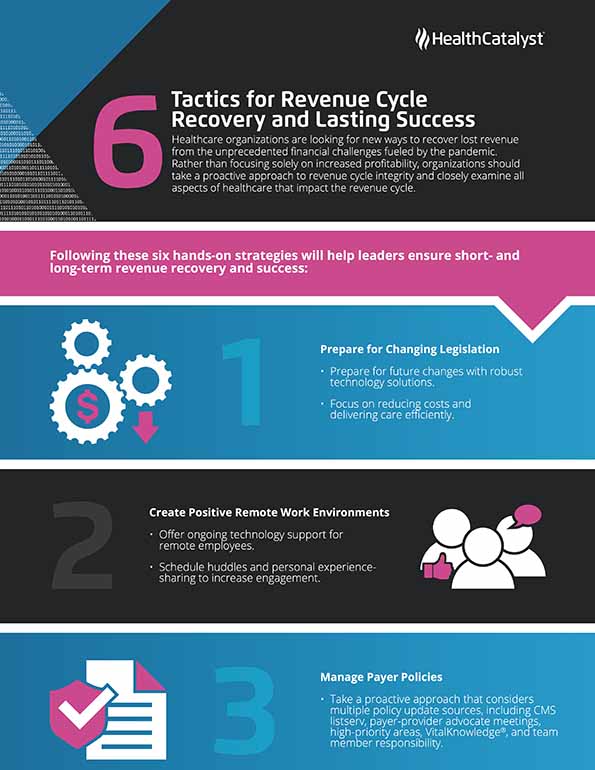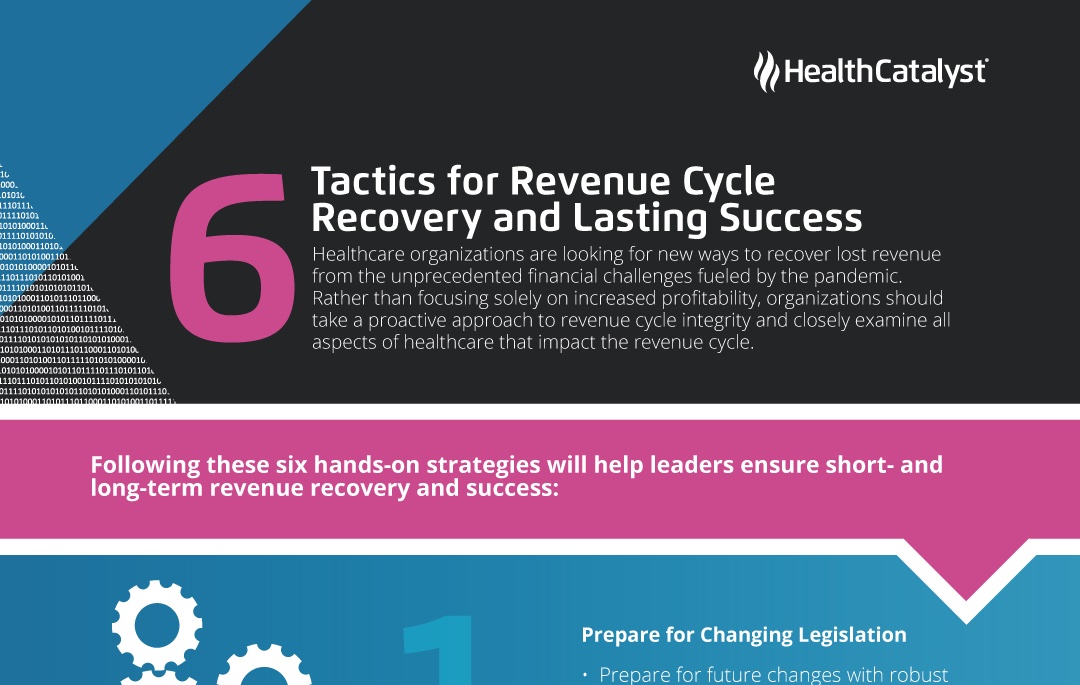Healthcare organizations suffered financial setbacks during the pandemic and are now looking for opportunities to recover lost revenue. Rather than focusing only on increasing profitability after months of halted elective procedures, health systems should closely examine other aspects of healthcare that impact the revenue cycle. To take a proactive approach to restore revenue cycle integrity, healthcare leaders should consider six hands-on strategies that promote near- and long-term revenue recovery:
1. Prepare for changing legislation.
2. Create positive remote work environments.
3. Manage payer policies.
4. Expand telehealth.
5. Set up prior authorization for surgical procedures.
6. Achieve price transparency.



This article is based on the webinar presentation, “New Ways Forward: A Panel Discussion on Navigating the Revenue Cycle in 2021,” with a panel of experts including Terri Rinker, MT (ASCP), MHA, Executive Director of Revenue Cycle Performance, Community Health Network; John Settlemyer, MBA, MHA, CPC, CHRI, Assistant Vice President, Revenue Cycle, Atrium Health; and Suzi Tschetter, MBA, CPA, Director, Revenue Integrity, Cleveland Clinic.
With the release of the COVID-19 vaccine and eased restrictions from the CDC, health systems are on the path to financial recovery. However, organizations still have a lot of work ahead to make up disruptions, including months of lost revenue from halted profitable elective procedures that cost health systems an average of $50 billion per month and changing reimbursement rates for telehealth services.
When it comes to revenue cycle improvement, many organizations think of operating margins, but the pandemic affected more than profitability. Facing new work environments and changing legislation (e.g., telemedicine reimbursement), revenue cycle teams must adapt to restore revenue integrity and keep up in this evolving healthcare landscape.
As organizations continue along the path of revenue cycle recovery, revenue cycle teams should consider how to adjust their traditional routines to the pandemic-induced changes including pivoting to remote work environments. Healthcare revenue cycle leaders should consider six proactive strategies to help them navigate pandemic-era changes and promote near- and long-term revenue cycle success:
During a period of legislative change that will likely focus on reimbursement, reducing costs and delivering care more efficiently will be a crucial factor for success. Technology is key for revenue cycle leaders in this uncertain environment, as it enables quick adaptation to new mandates. Health systems can prepare for future changes with robust financial products (e.g., Health Catalyst PowerCosting™) that attribute cost to every facet of a patient’s experience, providing insight into the true costs of care delivery.
Healthcare revenue experts also predict changes to the list of procedures that Medicare will reimburse and legislation to prevent surprise medical bills to patients. Surprise medical billing legislation will most likely aim to reduce out-of-network surprises (e.g., if an ambulance takes a patient to an out-of-network system).
Overall, revenue cycle leaders should pay attention to the economic impact of legislative initiatives. With awareness, organizations can prepare appropriately for changes, maintain important revenue streams, or compensate for loss in other areas.
The pandemic forced healthcare revenue cycle teams to transition from traditional in-person work settings to remote work environments. Many organizations lacked the technology, infrastructure, or culture for this rapid change. To provide a positive remote work experience, organizations can take a proactive approach by offering ongoing technical support in case of technical glitches. This allows revenue cycle team members to feel more connected to the company and each other and removes barriers, such as connectivity issues.
Other ways revenue cycle leaders can increase remote workplace engagement include the following:
Payer policies can change at any time, making it difficult for organizations to stay up to date on the latest developments. Additionally, payers don’t always communicate these policy changes to health systems, so organizations need a proactive policy approach that considers multiple policy update sources:
COVID-19 ignited an increase in telehealth, allowing health systems to comply with social distancing guidelines and still care for patients. Telehealth is critical for revenue because it allows care teams to track patients at risk for poor outcomes and chronic conditions, both of which can negatively impact a health system’s revenue. Providing consistent care via technology can prevent deteriorating health and therefore reduce costs for health systems.
For a sustainable telehealth approach, organizations should consider new telehealth technologies (e.g., sophisticated live video conferencing tools for better remote monitoring) and expanding telehealth to other service lines that will increase access to hard-to-reach populations, such as patients with limited transportation or impaired mobility.
Revenue cycle leaders should invest in pre-registration procedure processes. Pre-registration allows the health system to verify a patient’s coverage and obtain appropriate authorization from the patient’s insurance company before the procedure. Unfortunately, health systems may submit verification and authorization after the procedure, then don’t receive payment because the insurance company didn’t cover it. Prior authorization eliminates the risk of missed payments and ensures the health system receives payment for surgical services rendered.
Many health systems implemented the CMS-required price transparency regulations at the start of 2021. While this was a step toward achieving price transparency, additional requirements are on the way. Starting in 2022, CMS will require providers to generate good-faith price estimates for all services scheduled more than three days in advance and provide those estimates to the patient’s health plan or the patient (if the patient is uninsured).
Patient cost estimators—tools that use procedure cost information and a patient’s health insurance information to estimate the patient’s out of pocket cost—will play a key role in achieving price transparency. However, accurately predicting a patient’s costs relies on the health system knowing the correct billing structure and reimbursement they will receive from the payer. Price transparency aims to normalize point-of-service collections for patients. To further improve the patient billing experience, health systems should offer payment options, such as payment plans or alternative payment models.
As health systems settle into the next normal, revenue cycle leaders will continue to face an unpredictable pandemic aftermath. Healthcare revenue cycles have suffered, but organizations can now recover lost operating margins. Applying the six tactics for healthcare revenue cycle recovery and success described above and adopting an agile mindset will help revenue cycle leaders guide their teams with confidence, restore revenue integrity, and accelerate cashflow.
Would you like to learn more about this topic? Here are some articles we suggest:
Would you like to use or share these concepts? Download this presentation highlighting the key main points.